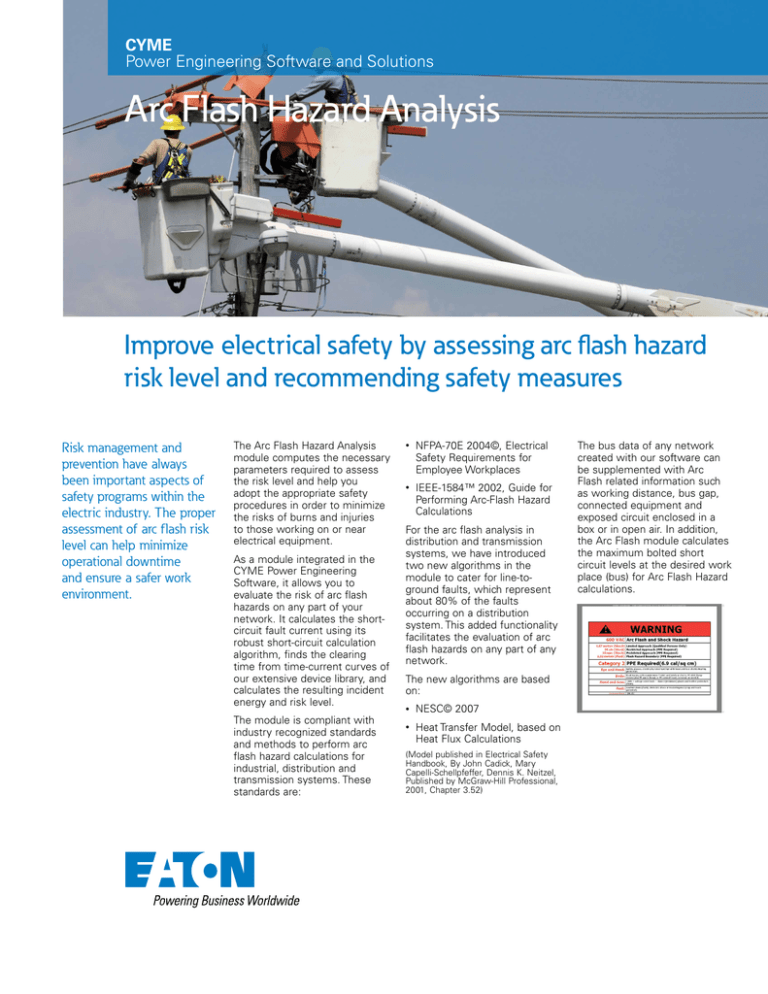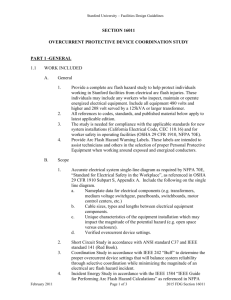
CYME
Power Engineering Software and Solutions
Arc Flash Hazard Analysis
Improve electrical safety by assessing arc flash hazard
risk level and recommending safety measures
Risk management and
prevention have always
been important aspects of
safety programs within the
electric industry. The proper
assessment of arc flash risk
level can help minimize
operational downtime
and ensure a safer work
environment.
The Arc Flash Hazard Analysis
module computes the necessary
parameters required to assess
the risk level and help you
adopt the appropriate safety
procedures in order to minimize
the risks of burns and injuries
to those working on or near
electrical equipment.
As a module integrated in the
CYME Power Engineering
Software, it allows you to
evaluate the risk of arc flash
hazards on any part of your
network. It calculates the shortcircuit fault current using its
robust short-circuit calculation
algorithm, finds the clearing
time from time-current curves of
our extensive device library, and
calculates the resulting incident
energy and risk level.
The module is compliant with
industry recognized standards
and methods to perform arc
flash hazard calculations for
industrial, distribution and
transmission systems. These
standards are:
•
NFPA-70E 2004©, Electrical
Safety Requirements for
Employee Workplaces
•
IEEE-1584™ 2002, Guide for
Performing Arc-Flash Hazard
Calculations
For the arc flash analysis in
distribution and transmission
systems, we have introduced
two new algorithms in the
module to cater for line-toground faults, which represent
about 80% of the faults
occurring on a distribution
system. This added functionality
facilitates the evaluation of arc
flash hazards on any part of any
network.
The new algorithms are based
on:
•
NESC© 2007
•
Heat Transfer Model, based on
Heat Flux Calculations
(Model published in Electrical Safety
Handbook, By John Cadick, Mary
Capelli-Schellpfeffer, Dennis K. Neitzel,
Published by McGraw-Hill Professional,
2001, Chapter 3.52)
The bus data of any network
created with our software can
be supplemented with Arc
Flash related information such
as working distance, bus gap,
connected equipment and
exposed circuit enclosed in a
box or in open air. In addition,
the Arc Flash module calculates
the maximum bolted short
circuit levels at the desired work
place (bus) for Arc Flash Hazard
calculations.
Arc Flash
Hazard Analysis
Model and include
substations, sub-networks
and secondary networks in
your simulations.
Capabilities
•
One-line diagram and userfriendly GUI for all systems
•
Batch mode simulation that
will allow the analysis for
every bus in the network in
one single simulation
•
Short-circuit current can be
calculated using ANSI® or
Conventional fault calculation
methods. Using ANSI®, the
reduced fault contribution of
motors and generators are
taken into consideration
•
•
Warning Labels
The program generates
warning labels that are ready
to be printed and affixed to the
electrical equipment. Different
label templates are available,
and it is also possible to create
custom warning labels.
These warning labels include all
the necessary information such
as:
•
Arc Flash Hazard boundary
•
Energy density
Calculation using default
values depicted by standards,
or using user-defined values
•
Hazard / Risk category class.
•
Personal Protective Equipment
(PPE).
Accurate opening time is
obtained from the protective
device time-current curve
library
•
Potential shock hazard.
•
Limited, restricted and
prohibited approach
boundaries
•
Equipment identification
•
The module is equipped
with the automatic detection
and validation of protection
schemes in the network
•
The display of results in a
tabular report
•
Possibility to generate
required results in a chart
Eaton
1000 Eaton Boulevard
Cleveland, OH 44122
United States
Eaton.com
CYME International T&D
1485 Roberval, Suite 104
St.Bruno, QC, Canada J3V 3P8
P: 450.461.3655 F: 450.461.0966
P: 800.361.3627 (Canada/USA)
CymeInfo@eaton.com
www.eaton.com/cyme
© 2015 Eaton All Rights Reserved
Printed in Canada
Publication No. BR 917 003 EN
November 2014
Eaton is a registered trademark.
All other trademarks are property
of their respective owners.
Follow us on social media to get the
latest product and support information.



